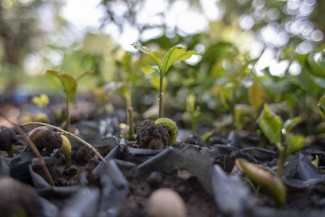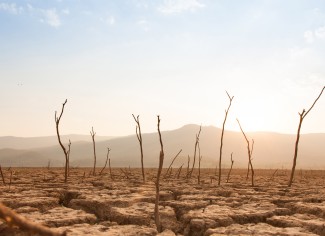Alexander Kasterine explores how climate change concerns are changing market requirements for developing country food exporters
Climate change related consumer power
Climate change is influencing the way consumers demand food. “Food miles” was an early expression of consumer power with farmers and campaigners in Europe and the US in the 2000s, promoting the idea that the distance a product travels from farm to the consumer contributes significantly to the overall carbon footprint of a food product.
The concept caused alarm for exporters in developing countries who are situated great distances from their export markets. In 2007, Soil Association, a leading UK organic certifier, announced that it was considering banning the certification of organic products that were airfreighted into the UK. Research carried out at the time showed that several thousands of African families were at risk of losing income if obstacles were placed to these premium price markets. After a consultation, the certifier decided against the idea, recognizing the benefits of trade for small-scale farmers in developing countries.
Maintaining market access
An expression, “fair miles”, was coined at time. It effectively won the argument over “food miles”. Given that the carbon footprint of farmers in sub-Saharan Africa is 30 times smaller than the consumers purchasing their products, it would only seem “fair” that they should have been able to transport their produce to market, whatever the distance involved.
Furthermore, despite contributing less than 4% of global greenhouse gas emissions (GHG), sub-Saharan Africa is highly vulnerable to the negative impacts of climate change. Placing barriers to market in the name of climate change is unpalatable in that respect.
De-bunking “food miles”
At the time, experts reached a consensus that “food miles” was a misleading proxy for sustainability of food products. The concept is still subject to scrutiny today. As showed by Xu et al in 2021, only 12% of food products’ greenhouse gas (GHG) emissions are associated with its transport to market. The majority of emissions are incurred during the production phase. The intensity of land management (e.g. ploughing, soil cultivation, planting crops, fertilization, irrigation), use of agrochemicals, processing and the extent of land clearance are all significant elements of the carbon footprint of food.
Dietary choices are also important in determining the carbon footprint of a household’s food shop. In 2008, Weber and Matthews showed that a shift away from red meat can be a more effective means of lowering an average household’s food-related climate footprint than “buying local.” Indeed, they found that “shifting less than one day per week’s worth of calories from red meat and dairy products to chicken, fish, eggs, or a vegetable-based diet achieves more GHG reduction than buying all locally sourced food”.
Airfreight is carbon intensive
While shipping and road transport adds little to the carbon footprint of food, airfreight adds a great deal.
Airfreight is used for perishable products including fruit and vegetables, fish and flowers. There are competitive advantages to using airfreight in terms of shorter and more reliable shipping times. Exporters in LDCs using airfreight include Ethiopia, Mali, Uganda and Senegal. Poore & Nemecek in 2018, calculated that it emits 50 times more CO2eq than a boat per tonne kilometre.
Impacts on exporters in LDCs
Beyond anecdotal evidence, there is little if any data on how “food miles” campaigns have affected LDC exports. According to the Food and Agriculture Organization (FAO), exports of fruits and vegetables from low-income countries grew threefold between 1995 and 2018. Exporters still occupy a niche in provision of counter-seasonal goods. There are signs that retailers in EU markets are encouraging suppliers to use shipping instead of airfreight.
Localism has broader objectives today
The “food miles” concept, whilst debunked, still persists as a credible concept in the mind of consumers and is promoted by farmers, food retailers and even influential organizations like United Nations. However, it now forms part of a wider objective of promoting local economic and climate resilience. Retailers in rich countries promote local food for its associations with “shortening supply chains”, building resilience and safeguarding biodiversity. Consumers responded to the COVID-19 lockdowns by seeking out local producers of food to fill the gap left by disrupted supply chains.
Measuring emissions impose costs on exporters
Food exporters in developing countries today face new climate related technical barriers and administrative costs. In response to their investor demands, for example the Task force on Climate related Disclosure (TCFD), and in recognition of the impact of climate change on their long term value performance, large companies are asking suppliers for information on their emissions in production of food (known as “Scope 3” emissions).
The numbers of companies measuring Scope 3 emissions is unknown and there is little transparency in data collection. However, the trend is clear. According to a company exporting food between African countries and the UK, “…retailers are now asking us to submit emissions data (via supplier web portals) and disclose any net-zero targets we are working towards and whether they are Science based Targets (SBT) approved”. Collection data on emissions can be a complex and costly exercise and so companies will incur additional costs if they want to comply with the new requirements.
LDC exporters in the future may also have new reporting costs to comply with the European Due Diligence Act covering environment, human rights and good governance. The Centre for the Promotion of Imports (CBI) at the Dutch Ministry of Foreign Affairs expects the legislation in 2023 to apply to large companies and ”high risk SMEs” both who in turn “…will have to identify and confirm the business practices of their suppliers and subcontractors. These could include contractual clauses, codes of conduct or certification by independent auditors”.
Companies face these risks and associated administrative burdens in addition to the costs of sustainability standards that they already engaged with.
It is worth keeping the perspective that the costs of the physical impacts of climate change for food exporters in Africa far exceed these market-related costs described here.
Climate change related market opportunities
Despite the high costs of adapting to climate change, there are emerging market opportunities for climate change related goods and services, both for mitigation and adaptation. Examples from adaptation as identified by the International Institute for Sustainable Development (IISD) include goods that manage adaptation risks in the value chain (e.g. clothing produced with special fibres that consume less water or food produced with recycled water), good used as inputs for adaptation efforts (e.g. drip irrigation) and adaptation services.
On the mitigation side, the need to reduce energy consumption by firms has created demand for resource efficiency services and circular economy innovations.
The Carbon Disclosure Project (CDP) goes so far to say that the opportunities for the 500 companies it surveyed in 2018 are bigger than the risks. Fostering innovation, increasing public sector investment in R&D, accessing green finance and linking to markets will be key to building success in this field.
Increasing climate compliance with some opportunities
In 2007, “food miles” was seen as a market access threat to businesses in African food exporting countries. It is a misguided and unhelpful concept but one that has proven to be durable. Today, climate-related market barriers are manifested in carbon auditing and compliance processes. These can be technically challenging and carry administrative costs, something that smaller companies may struggle with. In addition to the meeting the costs of adaptation, finding a way to comply with these processes will be part of any successful company’s business strategy. As will identifying and exploiting new market opportunities in climate related goods and services.
Alexander Kasterine is Senior Advisor, Division for Enterprises and Institutions, International Trade Centre (UNCTAD/WTO).This article presents the views of the author and does not necessarily represent the views of the ITC. It was prepared following the WTO Trade Dialogue on Food on “Food Miles”, 5th October 2021. The author extends his gratitude to the WTO for the invitation to attend as a panellist and to Robert Hamwey (UNCTAD), Mathieu Lamolle and Bilal Qureshi (both ITC) for providing comments on this draft. Any errors are the author’s alone.
If you would like to reuse any material published here, please let us know by sending an email to EIF Communications: eifcommunications@wto.org.



